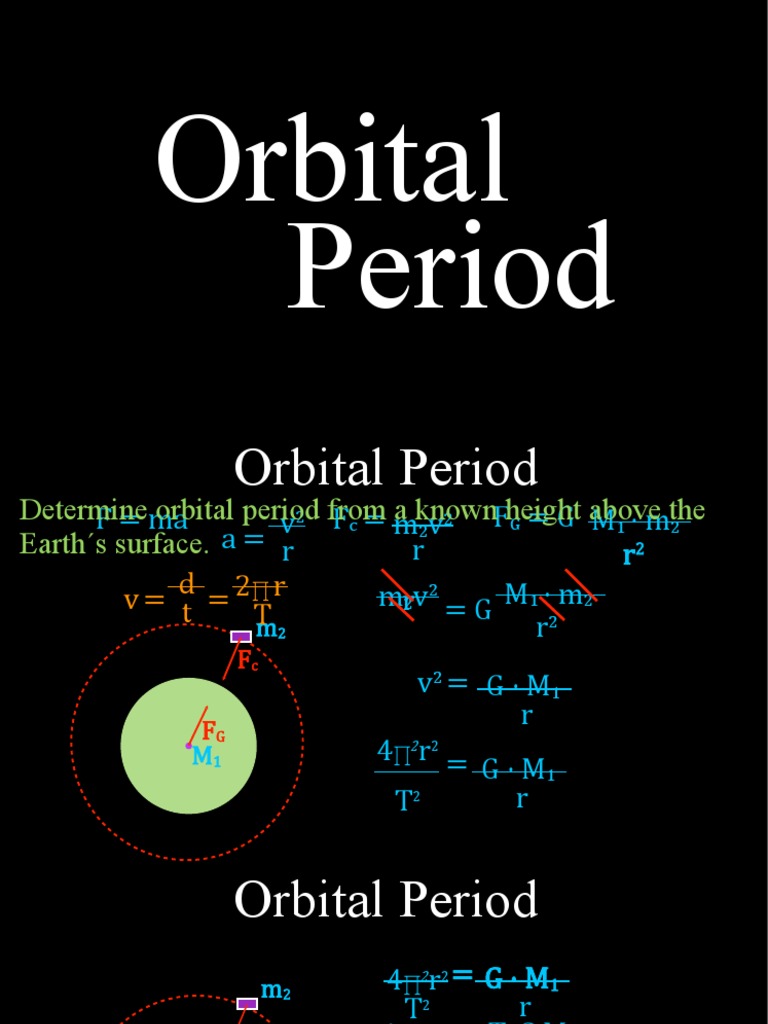How to Calculate an Orbital Period

Understanding the orbital period is crucial in the study of celestial mechanics and astronomy. It provides valuable insights into the dynamics of our solar system and beyond. In this comprehensive guide, we will delve into the methods and calculations involved in determining the orbital period of celestial bodies, shedding light on the fascinating dance of planets, moons, and other cosmic entities.
Unraveling the Concept of Orbital Period

The orbital period, often simply referred to as “period,” is the time taken by a celestial body to complete one full orbit around its parent body. This concept is fundamental in astronomy, as it allows us to quantify the motion and behavior of objects within our solar system and beyond. Whether it’s the Earth’s journey around the Sun or the moon’s orbit around our planet, the orbital period offers a precise measurement of time.
To calculate an orbital period, we must consider several key factors, including the gravitational force between the bodies, their masses, and the distance between them. These factors collectively influence the speed and trajectory of the orbiting body, ultimately determining the duration of its orbit.
The Keplerian Approach: A Historical Perspective

The mathematical foundations for calculating orbital periods can be traced back to the works of Johannes Kepler, a German mathematician and astronomer. Kepler’s laws of planetary motion, formulated in the early 17th century, provided a groundbreaking framework for understanding celestial orbits.
One of Kepler's seminal contributions was his second law, often referred to as the law of equal areas. This law states that an imaginary line connecting a planet to the Sun will sweep out equal areas in equal intervals of time. In simpler terms, it means that a planet moves faster when it is closer to the Sun and slower when it is farther away, ensuring that the areas covered during its orbit are equal over time.
Building upon this law, Kepler's third law, known as the harmonic law, established a mathematical relationship between the orbital period of a planet and its distance from the Sun. This law, expressed as P² ∝ a³, where P is the orbital period and a is the semi-major axis of the orbit, provided a powerful tool for calculating orbital periods.
Kepler's laws not only revolutionized our understanding of planetary motion but also laid the foundation for subsequent advancements in celestial mechanics.
Calculating Orbital Periods: A Modern Approach
While Kepler’s laws remain integral to our understanding of celestial mechanics, modern calculations of orbital periods often utilize more advanced mathematical models and computational techniques. These methods take into account the complex interactions between celestial bodies, accounting for factors such as gravitational perturbations, tidal effects, and even the influence of other nearby objects.
Kepler’s Third Law Revisited
Let’s revisit Kepler’s third law, which serves as a cornerstone for calculating orbital periods. This law, expressed as P² = a³, where P is the orbital period in years and a is the semi-major axis of the orbit in astronomical units (AU), provides a simple yet powerful formula for determining the orbital period of a planet or moon.
For instance, let's consider the Earth's orbit around the Sun. The semi-major axis of the Earth's orbit is approximately 1 AU, and using Kepler's third law, we can calculate its orbital period as follows:
| Earth's Orbital Period | Calculated Value |
|---|---|
| Orbital Period (P) | 1 year |

This calculation aligns perfectly with our observation that the Earth takes one year to complete its orbit around the Sun.
Beyond Planets: Calculating Orbital Periods of Moons and Asteroids
The principles of orbital period calculation extend beyond planets to encompass moons, asteroids, and other celestial bodies. For example, let’s consider the moon’s orbit around the Earth. The semi-major axis of the moon’s orbit is approximately 0.00257 AU, and using Kepler’s third law, we can calculate its orbital period as follows:
| Moon's Orbital Period | Calculated Value |
|---|---|
| Orbital Period (P) | 27.32 days |
Similarly, for asteroids or other small bodies, the calculation remains the same, utilizing the semi-major axis of their orbits to determine their orbital periods.
Perturbations and Complex Orbits
In reality, the orbits of celestial bodies are not always perfectly circular or unaffected by external influences. Gravitational perturbations from other bodies, such as planets or moons, can introduce complexities into the orbital dynamics. These perturbations can lead to eccentric orbits, where the shape of the orbit deviates from a perfect circle.
To account for these complexities, more advanced mathematical models and numerical simulations are employed. These models consider the gravitational interactions between multiple bodies, allowing for a more accurate determination of orbital periods, especially in dynamic and complex systems.
Real-World Applications and Implications
The calculation of orbital periods has numerous practical applications and implications in astronomy and space exploration.
Exploring the Solar System
Understanding the orbital periods of planets and moons within our solar system is crucial for planning space missions and studying the dynamics of our celestial neighborhood. By accurately calculating these periods, astronomers can predict the positions of celestial bodies, facilitating the planning of interplanetary missions and ensuring precise navigation.
Discovering Exoplanets
In the search for exoplanets, the calculation of orbital periods plays a vital role. Astronomers often detect exoplanets by observing the subtle wobbles or transits of stars caused by the gravitational influence of orbiting planets. By analyzing these wobbles or transits and calculating the orbital periods, researchers can confirm the presence of exoplanets and gain insights into their characteristics.
Understanding Binary Star Systems
In binary star systems, where two stars orbit a common center of mass, the calculation of orbital periods is essential for understanding the dynamics and evolution of these systems. By studying the orbital periods and other characteristics, astronomers can uncover insights into the formation and behavior of stars and their interaction with each other.
The Future of Orbital Period Calculations

As our understanding of celestial mechanics and computational capabilities continue to advance, the methods for calculating orbital periods will likely become even more precise and sophisticated. With the development of advanced algorithms and simulations, astronomers and scientists will be able to explore more complex systems and gain deeper insights into the universe’s intricacies.
Moreover, with the ongoing exploration of our solar system and the discovery of new exoplanets, the calculation of orbital periods will play a pivotal role in unraveling the mysteries of celestial bodies and their interactions.
How accurate are the calculations of orbital periods using Kepler’s laws?
+
Kepler’s laws provide a remarkably accurate framework for calculating orbital periods, especially for simple, circular orbits. However, for more complex and eccentric orbits, additional factors and perturbations need to be considered, leading to more advanced mathematical models.
What are the challenges in calculating orbital periods for objects with highly eccentric orbits?
+
Highly eccentric orbits present challenges due to the varying gravitational forces experienced by the orbiting body. These variations require more sophisticated mathematical models and numerical simulations to accurately account for the changes in velocity and position.
How do astronomers determine the semi-major axis of an orbit for calculating orbital periods?
+
The semi-major axis of an orbit is typically determined through a combination of observations and mathematical calculations. Astronomers use techniques such as astrometry, which involves precise measurements of celestial body positions, to estimate the orbit’s shape and dimensions.



